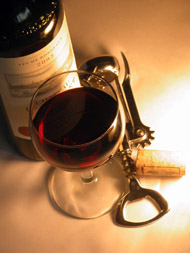Home Page> Wine Glasses
Guide To Buying Wine Glasses
Wine Glasses Article From www.wine-blog.net
Author: Brian Johnson
You’ve heard somewhere or read somewhere that wine must be served in the best crystal to get its full advantage, well not necessarily but there are a few basic principles to remember when choosing glasses that will help you get the best from your favorite bottle.
It is true however that the appearance, smell and even the taste can be enhanced by using the proper glasses. The oldest surviving wine glass with a stem and foot are 15th century enameled goblets that holds more than four ounces of liquid. Towards the end of the 16th century in Germany, wine glasses are sophistically engraved as decoration . Meanwhile The earliest surviving English wine glasses that were produced near the end of the 16th century were made by Verzelini, there were diamond-engraved. Around the 1740s plain straight stems and air twist stems gained popularity . France introduced fine crystal glasses towards the end of the 18th century.
Wine glasses during the 19th century were often produced in sets of a dozen each, each set for port and sherry, burgundy and claret, champagne glasses and liqueur glasses. In the 1950s, Riedel Crystal and other manufacturers have refined the design of wine glasses with unique size and shape for almost every wine variation.
When choosing glasses, always remember to first choose a plain glass to set off your best wines, stay away from colored or even those that have tinted stems or bases. The effect of light on the wine, specifically the “legs” and “tears’ on the inner wall when you swirl the wine and the way aromas are captured within the wine glass and finally presented to your nose while drinking are one of the most important things to consider when choosing wine glasses. Glasses with a wide bowl that tapers toward the mouth will allow the aroma of the wine to be released generously. This is because the deeper bowls allow more room for swirling and the narrow opening channels the aroma to your nostrils efficiently. A big flared opening will disperse the aroma rather quicker.
Red wines are traditionally served in bigger glasses than white wine, this is because red wines needs more space to breathe and develop, remember, a wine glass can never be too big. Sparkling wines should be served in think glasses with straight side or flutes so that the fizz is preserved.
Realizing the plight of budget restricted consumers, the California Wine Institute has developed an all-purpose wine glass. It is five and one half inches tall with a one and three quarter inch stem. Its clear, tulip-shaped bowl holds a capacity of up to eight ounces.
Setting of wine glasses at a dinner party should also be taken into consideration when serving different types of wine throughout each course. The glasses should be arranged in the order they are to be used and right to left. Typically wine is poured from the right, while food is served from the left. You might want to begin with tall stemmed glass for whites followed by a large wine goblet for reds and ending with short smaller glass for port or sherry. Finally remember that you need to leave room to capture the aroma as it rises from the swirled wine and allowing room for it to be tilted to evaluate the color of the wine, therefore it’s best to fill the wine glass at one third to one half full at the most.
About The Author:
Stop by wine-blog today for the latest information about the wine world, with great wine articles, wine in the news and more. http://www.wine-blog.net/

Bookmark Us:







